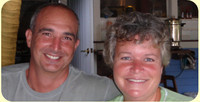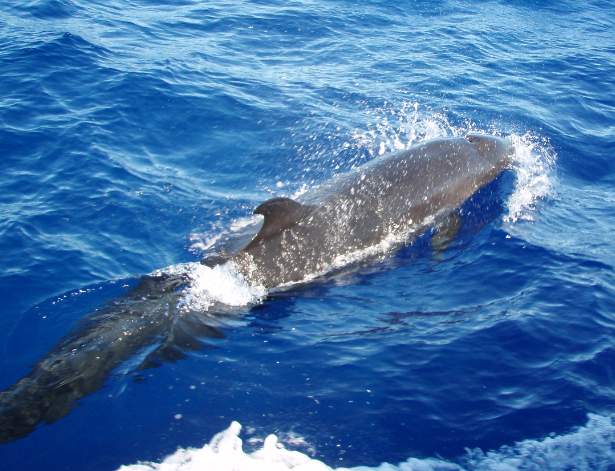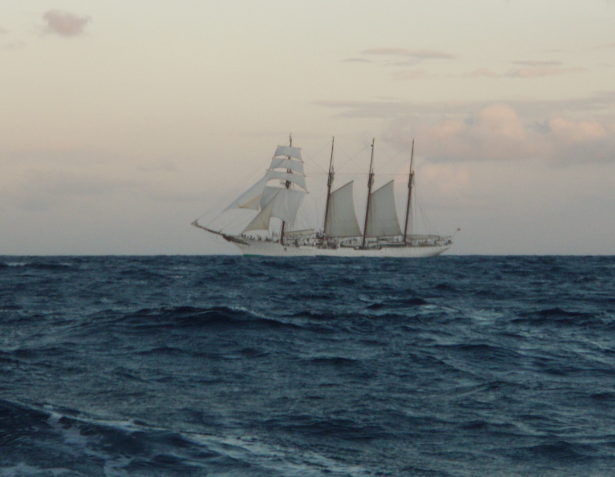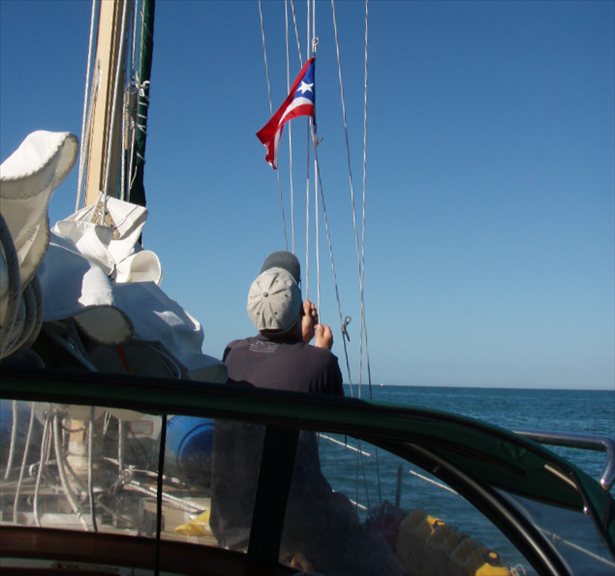

- PHOTOS:
- Dec 16, 2008 - May 21, 2009
- Mar 17, 2008 - Dec 15, 2008
- Nov 01, 2007 - Mar 16, 2008
- Our SC35 Sailboat: PRUDENCE
- SELECTED BLOGS
- Jan'05: The Idea
- May'05: First Cruise - Belize
- Aug'05: Buying Ashiya
- Oct'05: School in St. Vincent
- Nov'05: Ocracoke on Ashiya
- Jul'06: Long Trip on Ashiya
- Oct'06: Prudence Comes Home
- Nov'07: First Night Offshore
- Nov'07: Offshore Take Two
- Nov'07: Gulf Stream Crossing
- Dec'07: Green Turtle Cay
- Dec'07: Lynyard Cay
- Dec'07: Warderick Wells Cay
- Jan'08: George Town
- Jan'08: Life without a Fridge
- Jan'08: Mayaguana Island
- Jan'08: Turks & Caicos
- Jan'08: Dominican Republic
- Jan'08: Down the Waterfalls
- Feb'08: Puerto Rico
- Feb'08: Starter Troubles
- Feb'08: Vieques
- Mar'08: Finally Sailing Again
- Mar'08: Trip So Far
- Mar'08: Hiking Culebra
- Mar'08: Kayak & Snorkel I
- Mar'08: Teak and Waterspouts
- Mar'08: Kayak & Snorkel II
- Mar'08: Bottom Cleaning
- Apr'08: Culebra Social Life
- Apr'08: Culebra Routine
- Apr'08: Culebra Beaches
- Apr'08: Culebrita
- Jun'08: Kayak & Snorkel III
- Jun'08: Kayak & Snorkel IV
- Jun'08: Manta Ray
- Jun'08: Sea Turtles
- Jul'08: Cost of Cruising
- Jul'08: Busy Week in Culebra
- Jul'08: Getting to Land
- Jul'08: Leatherback Boil
- Jul'08: Fish and Volcano Dust
- Aug'08: Teaching Algebra
- Sep'08: Culebra Card Club
- Oct'08: Kayak & Snorkel V
- Oct'08: Prep for Hurricane
- Oct'08: Hurricane Omar
- Oct'08: Fish and Sea Glass
- Oct'08: Waterspouts
- Dec'08: Hurricane Season Ends
- Dec'08: Culebra to St. Martin
- Jan'09: Antigua Part 1
- Feb'09: The Saints
- Feb'09: Visiting Dominica
- Mar'09: Antigua Part 2
- Apr'09: Antigua to Bermuda
- May'09: Bermuda to Norfolk
- FULL LIST of Blog Entries
15 July 2009
14 July 2009
15 June 2009
14 June 2009 | Annapolis, MD
13 June 2009
12 June 2009
11 June 2009
10 June 2009 | Little Creek Marina, Norfolk, VA, USA
04 June 2009 | Little Creek Marina, Norfolk, VA, USA
31 May 2009 | Little Creek Marina, Norfolk, VA, USA
29 May 2009 | Little Creek Marina, Norfolk, VA, USA
26 May 2009 | Little Creek Marina, Norfolk, VA, USA
25 May 2009 | Little Creek Marina, Norfolk, VA, USA
13 May 2009 | through 21-May-2009
13 May 2009 | through 21-May-2009
12 May 2009 | St George's Town, Bermuda
11 May 2009 | St George's Town, Bermuda
07 May 2009 | St George's Town, Bermuda
04 May 2009 | St George's Town, Bermuda
21 April 2009 | through 02-May-2009
There was no Incident Crossing the Mona Passage
12 February 2008 | Boquer�n, Puerto Rico

CURRENT LOCATION: Anchored in the Bah�a de Boquer�n, off the city of Boquer�n, Puerto Rico
18 01.326' N, 067 10.804' W
The Mona Passage was easy. I imagine that you won't find too many cruisers writing that statement in their blog. I suppose that we just got lucky. Well, luck and a strict adherence to Van Sant's Rules.
We left Saman� at dusk and rounded Cabo Rafael in the wee hours of the morning. In an effort to provide some opportunity for the rest we both so desperately needed, we decided to do this entire passage with 3 hour shifts, and (please) sleep below if you are able. It was my shift going from 4AM to 7AM, as we motorsailed along our final portion of the north coast of the Dominican Republic. Here, all of Van Sant's Rules from staying close to land to avoiding the garbage line were spot on. I found smooth water and light winds close to shore and was able to keep our speeds up for maximum progress in the ebbing night lee. The man may not know how to write a useful or even intelligible book, but he does know how to sail this area.
At the end of my shift, we decided to tack away from the shore, as Van Sant's Rule: Leave the Coast by 8AM would keep us from getting the negative side of the land effects. As we sailed northeast, we kept waiting for the winds to pick up, but they never did. We turned our motorsail into mostly a motoring experience and ran the rhum line to the top of Hourglass Shoals. These waters are not truly 'shoal,' as they run up to over a hundred feet deep, but they are relatively shallow when compared with the adjacent Puerto Rico Trench. At one point we did see our depth sounder drop precipitously; however, this turned out to be the result of dolphins playing below our boat. Really BIG dolphins, as the photo above may suggest.
Once we were past the shoals, which are reputed to be the most dangerous aspect of the Mona, the winds did pick up some, but only for a few hours. During this time, we probably had too much sail up, but we were making good time along our rhum line and this close to the wind, it was manageable. At least it was, until another ship appeared on the horizon. This big ship had an odd shape about it. When it finally got close enough to see in the binoculars, we realized that we were dealing with a tall ship, a four masted square rigged schooner...

The photo above was not taken in such close proximity by choice, though. I would have preferred to remain on our nicely dialed-in point of sail throughout the night; however, once this boat got to the 2 nautical mile range on the radar, it was time to hail them. When they did not answer our hails, we had to drop the main before we could fall off (full main in 25+ knots of wind would have been dangerous on anything but a close-hauled point of sail).
Once we got around the BIG boat, we got back onto our rhum line with a single reef now in the main. The winds settled as we closed in on the Puerto Rican coast (about 25 nautical miles out), due to the night lee and the wind shadow on the western end of the island. We motored through calm water right up and into the harbor at Mayag�ez. We prefer not to make it a habit of entering strange harbors at night, but this is a large ship harbor, very well marked, very open, very deep, and very easy to enter. Add that to the current flat-calm conditions and you have no problems, whatsoever, with a night entry.
What we did have a problem with was anchoring. The spot we wanted to anchor, near the pier with Customs and Immigration, was just too hard to find in the dark. We got nervous on our first attempt to approach the area. You would not believe how disorienting the combination of darkness on the water and the bright lights of land can be. Therefore, we decided, instead, to go to the far side of the harbor (out of the way of any big ship traffic) and go into another stalling pattern. In fact, with these light winds we could simply drift most of the time.
We scoped out an area for drifting, and then Sheryl monitored the helm while I assembled the dinghy. When first light arrived, we were ready. We motored up to the desired anchor spot and dropped the hook. We had been told by numerous experienced cruisers and both guidebooks we have for Puerto Rico that the holding in Mayag�ez harbor is atrocious. Well, I am here to tell you that our experience differs. We came around between buoys #8 and #10, just off the pier, then went about halfway between them and about three boat lengths beyond them before deploying the CQR in 12 feet of water. When we set it, it set well. When we retrieved it two hours later, it was hard to remove and packed with rust-colored mud.
We quickly put on some clean clothes and deployed the dinghy. Evinrude started and ran smoothly as we headed to the pier (a testimony to the smooth passage we had made). We had been warned about the pier by others. It is a BIG ship pier and has no provisions for disembarking from a dinghy. No problem, though, we simply tied up to a fender (which was larger than our dinghy), suspended from the top of the pier by a huge chain. We climbed up onto the links of chain and then onto the concrete surface of the pier. Getting up was not what I would call easy, but certainly not the impossible feat others would have had us believe.
We answered all the questions from Customs and Immigration, and Sheryl responded with one of her own (generated largely from her experiences in previous countries), "How long can we stay?" The agent smiled and said, "This is a US territory, you can stay the rest of your lives if you wish." Now there is an idea, I thought to myself.
Now that we were official, we decided to move the boat to a more scenic location than our current anchorage. We motored two hours through mostly calm waters to the mouth of Bah�a de Boquer�n and entered in increasing afternoon winds. We set the anchor in over 20 knots of wind and went about the task of cleaning up the boat. Once we were settled, the winds did likewise, so we headed into town. After a little exploration, a couple of drinks, and some marvelous cheese quesadillas as an appetizer, we returned to the boat for dinner. Sheryl started the rice in our pressure cooker and opened one of the treasured packages of Indian food we have in our stores (Palak Paneer in a boil-in-the-bag pouch).
Unfortunately, when the meal was ready (less than an hour later) I had fallen asleep. It was such a sound sleep that Sheryl ate alone before going to bed. That was O.K., though, because I enjoyed Indian food for breakfast the next day.
As it turns out, we could have gone directly to Boquer�n and cleared in by phone. Several cruisers in the anchorage here successfully did that. Of course, it took some a while because there are numerous phone numbers out there for clearing in, and only one will do it without asking you to travel to Mayag�ez. I guess that is bureaucracy in action, if you don't like the answer you get, ask someone else. For us, though, the brief stop at Mayag�ez was worth the effort (considering that we do not have a phone).
So here I sit, pinching myself, to make sure that I am not dreaming...we are really here, in Puerto Rico, on our own boat. How cool!

18 01.326' N, 067 10.804' W
The Mona Passage was easy. I imagine that you won't find too many cruisers writing that statement in their blog. I suppose that we just got lucky. Well, luck and a strict adherence to Van Sant's Rules.
We left Saman� at dusk and rounded Cabo Rafael in the wee hours of the morning. In an effort to provide some opportunity for the rest we both so desperately needed, we decided to do this entire passage with 3 hour shifts, and (please) sleep below if you are able. It was my shift going from 4AM to 7AM, as we motorsailed along our final portion of the north coast of the Dominican Republic. Here, all of Van Sant's Rules from staying close to land to avoiding the garbage line were spot on. I found smooth water and light winds close to shore and was able to keep our speeds up for maximum progress in the ebbing night lee. The man may not know how to write a useful or even intelligible book, but he does know how to sail this area.
At the end of my shift, we decided to tack away from the shore, as Van Sant's Rule: Leave the Coast by 8AM would keep us from getting the negative side of the land effects. As we sailed northeast, we kept waiting for the winds to pick up, but they never did. We turned our motorsail into mostly a motoring experience and ran the rhum line to the top of Hourglass Shoals. These waters are not truly 'shoal,' as they run up to over a hundred feet deep, but they are relatively shallow when compared with the adjacent Puerto Rico Trench. At one point we did see our depth sounder drop precipitously; however, this turned out to be the result of dolphins playing below our boat. Really BIG dolphins, as the photo above may suggest.
Once we were past the shoals, which are reputed to be the most dangerous aspect of the Mona, the winds did pick up some, but only for a few hours. During this time, we probably had too much sail up, but we were making good time along our rhum line and this close to the wind, it was manageable. At least it was, until another ship appeared on the horizon. This big ship had an odd shape about it. When it finally got close enough to see in the binoculars, we realized that we were dealing with a tall ship, a four masted square rigged schooner...

The photo above was not taken in such close proximity by choice, though. I would have preferred to remain on our nicely dialed-in point of sail throughout the night; however, once this boat got to the 2 nautical mile range on the radar, it was time to hail them. When they did not answer our hails, we had to drop the main before we could fall off (full main in 25+ knots of wind would have been dangerous on anything but a close-hauled point of sail).
Once we got around the BIG boat, we got back onto our rhum line with a single reef now in the main. The winds settled as we closed in on the Puerto Rican coast (about 25 nautical miles out), due to the night lee and the wind shadow on the western end of the island. We motored through calm water right up and into the harbor at Mayag�ez. We prefer not to make it a habit of entering strange harbors at night, but this is a large ship harbor, very well marked, very open, very deep, and very easy to enter. Add that to the current flat-calm conditions and you have no problems, whatsoever, with a night entry.
What we did have a problem with was anchoring. The spot we wanted to anchor, near the pier with Customs and Immigration, was just too hard to find in the dark. We got nervous on our first attempt to approach the area. You would not believe how disorienting the combination of darkness on the water and the bright lights of land can be. Therefore, we decided, instead, to go to the far side of the harbor (out of the way of any big ship traffic) and go into another stalling pattern. In fact, with these light winds we could simply drift most of the time.
We scoped out an area for drifting, and then Sheryl monitored the helm while I assembled the dinghy. When first light arrived, we were ready. We motored up to the desired anchor spot and dropped the hook. We had been told by numerous experienced cruisers and both guidebooks we have for Puerto Rico that the holding in Mayag�ez harbor is atrocious. Well, I am here to tell you that our experience differs. We came around between buoys #8 and #10, just off the pier, then went about halfway between them and about three boat lengths beyond them before deploying the CQR in 12 feet of water. When we set it, it set well. When we retrieved it two hours later, it was hard to remove and packed with rust-colored mud.
We quickly put on some clean clothes and deployed the dinghy. Evinrude started and ran smoothly as we headed to the pier (a testimony to the smooth passage we had made). We had been warned about the pier by others. It is a BIG ship pier and has no provisions for disembarking from a dinghy. No problem, though, we simply tied up to a fender (which was larger than our dinghy), suspended from the top of the pier by a huge chain. We climbed up onto the links of chain and then onto the concrete surface of the pier. Getting up was not what I would call easy, but certainly not the impossible feat others would have had us believe.
We answered all the questions from Customs and Immigration, and Sheryl responded with one of her own (generated largely from her experiences in previous countries), "How long can we stay?" The agent smiled and said, "This is a US territory, you can stay the rest of your lives if you wish." Now there is an idea, I thought to myself.
Now that we were official, we decided to move the boat to a more scenic location than our current anchorage. We motored two hours through mostly calm waters to the mouth of Bah�a de Boquer�n and entered in increasing afternoon winds. We set the anchor in over 20 knots of wind and went about the task of cleaning up the boat. Once we were settled, the winds did likewise, so we headed into town. After a little exploration, a couple of drinks, and some marvelous cheese quesadillas as an appetizer, we returned to the boat for dinner. Sheryl started the rice in our pressure cooker and opened one of the treasured packages of Indian food we have in our stores (Palak Paneer in a boil-in-the-bag pouch).
Unfortunately, when the meal was ready (less than an hour later) I had fallen asleep. It was such a sound sleep that Sheryl ate alone before going to bed. That was O.K., though, because I enjoyed Indian food for breakfast the next day.
As it turns out, we could have gone directly to Boquer�n and cleared in by phone. Several cruisers in the anchorage here successfully did that. Of course, it took some a while because there are numerous phone numbers out there for clearing in, and only one will do it without asking you to travel to Mayag�ez. I guess that is bureaucracy in action, if you don't like the answer you get, ask someone else. For us, though, the brief stop at Mayag�ez was worth the effort (considering that we do not have a phone).
So here I sit, pinching myself, to make sure that I am not dreaming...we are really here, in Puerto Rico, on our own boat. How cool!

| Vessel Name: | Prudence |
| About: |
Gallery not available

- PHOTOS:
- Dec 16, 2008 - May 21, 2009
- Mar 17, 2008 - Dec 15, 2008
- Nov 01, 2007 - Mar 16, 2008
- Our SC35 Sailboat: PRUDENCE
- SELECTED BLOGS
- Jan'05: The Idea
- May'05: First Cruise - Belize
- Aug'05: Buying Ashiya
- Oct'05: School in St. Vincent
- Nov'05: Ocracoke on Ashiya
- Jul'06: Long Trip on Ashiya
- Oct'06: Prudence Comes Home
- Nov'07: First Night Offshore
- Nov'07: Offshore Take Two
- Nov'07: Gulf Stream Crossing
- Dec'07: Green Turtle Cay
- Dec'07: Lynyard Cay
- Dec'07: Warderick Wells Cay
- Jan'08: George Town
- Jan'08: Life without a Fridge
- Jan'08: Mayaguana Island
- Jan'08: Turks & Caicos
- Jan'08: Dominican Republic
- Jan'08: Down the Waterfalls
- Feb'08: Puerto Rico
- Feb'08: Starter Troubles
- Feb'08: Vieques
- Mar'08: Finally Sailing Again
- Mar'08: Trip So Far
- Mar'08: Hiking Culebra
- Mar'08: Kayak & Snorkel I
- Mar'08: Teak and Waterspouts
- Mar'08: Kayak & Snorkel II
- Mar'08: Bottom Cleaning
- Apr'08: Culebra Social Life
- Apr'08: Culebra Routine
- Apr'08: Culebra Beaches
- Apr'08: Culebrita
- Jun'08: Kayak & Snorkel III
- Jun'08: Kayak & Snorkel IV
- Jun'08: Manta Ray
- Jun'08: Sea Turtles
- Jul'08: Cost of Cruising
- Jul'08: Busy Week in Culebra
- Jul'08: Getting to Land
- Jul'08: Leatherback Boil
- Jul'08: Fish and Volcano Dust
- Aug'08: Teaching Algebra
- Sep'08: Culebra Card Club
- Oct'08: Kayak & Snorkel V
- Oct'08: Prep for Hurricane
- Oct'08: Hurricane Omar
- Oct'08: Fish and Sea Glass
- Oct'08: Waterspouts
- Dec'08: Hurricane Season Ends
- Dec'08: Culebra to St. Martin
- Jan'09: Antigua Part 1
- Feb'09: The Saints
- Feb'09: Visiting Dominica
- Mar'09: Antigua Part 2
- Apr'09: Antigua to Bermuda
- May'09: Bermuda to Norfolk
- FULL LIST of Blog Entries





